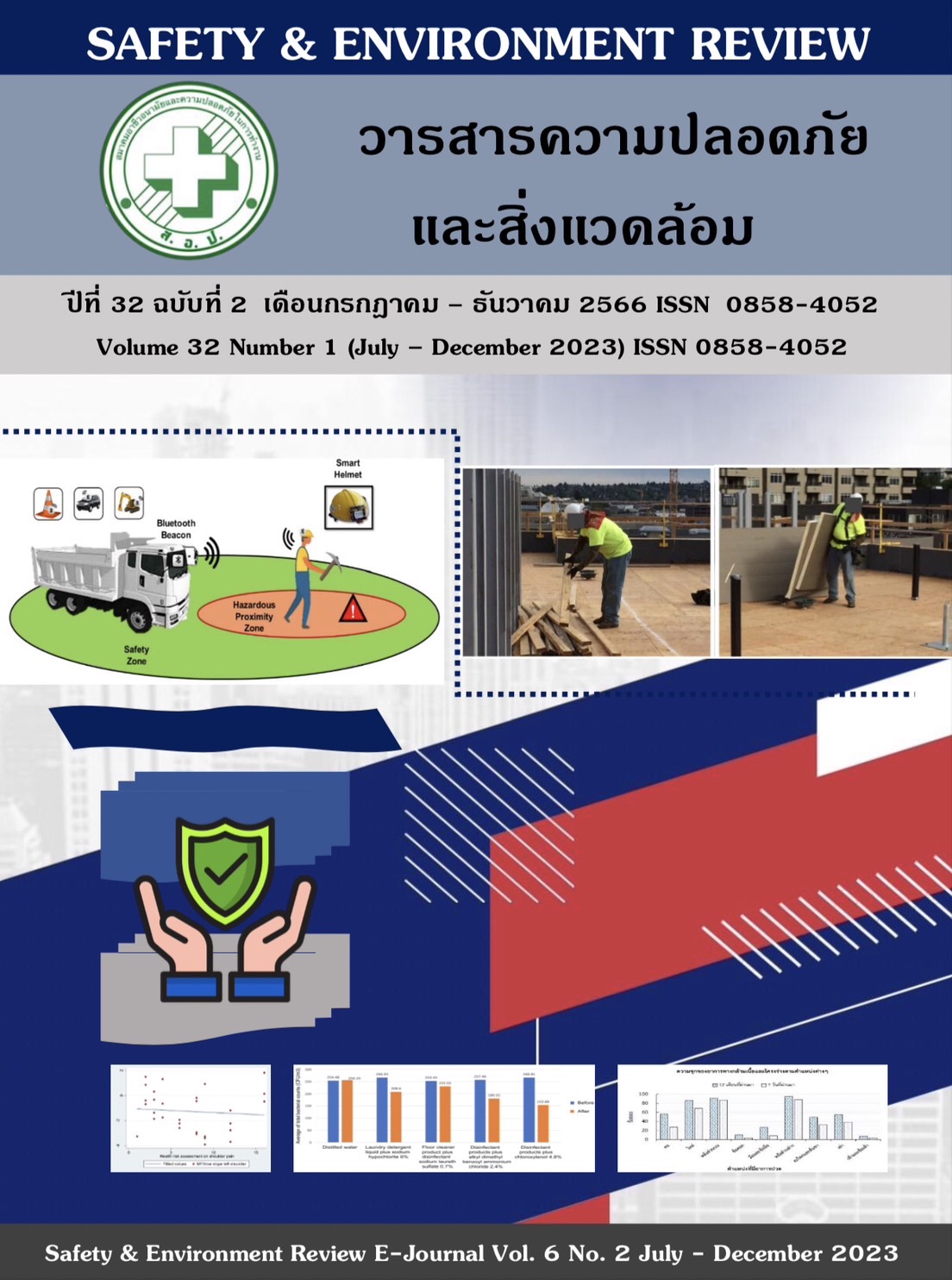ความเสี่ยงทางสุขภาพต่อการปวดไหล่และความล้าของกล้ามเนื้อไหล่จากการตรวจคลื่นไฟฟ้ากล้ามเนื้อในพนักงานผลิตและประกอบชิ้นส่วนอิเล็กทรอนิกส์
HEALTH RISK ON SHOULDER PAIN AND SHOULDER MUSCLE FATIGUE BY ELECTROMYOGRAPHY (EMG) IN ELECTRONIC INDUSTRIAL WORK
Keywords:
health risk matrix, electromyography (EMG), fatigue, shoulder pain, electronic workerAbstract
This cross-sectional descriptive study aimed to assess the health risks of shoulder pain and shoulder muscle fatigue by electromyography (EMG) measurement in electronic workers. Data were collected by using a structured interview questionnaire, Musculoskeletal disorders Severity and Frequency Questionnaire (MSFQ), Rapid Upper Limb Assessment, and health risk assessment matrix for shoulder pain and EMG measurement. Data were analyzed using descriptive statistics. The results of the study found that most workers had mild shoulder discomfort (34.5%). The ergonomic risk level of the upper limb found that most workers were at the moderate risk level (39.9%). The health risk level of shoulder pain found that workers were in the moderate to high risk (54.9%). The electromyography (EMG) on the shoulder fatigue throughout 8 working hours, there was the higher fatigue level (MF/Time slope) of the left shoulder (MF/Time slope = -1.250) compared to right shoulders (MF/Time slope = –0.998, respectively). When considering the shoulder muscle fatigue according to the 4 levels of health risk on the shoulder pain, it was found that the left shoulders muscle in the high and very high risk level showed higher fatigue (MF/time slope = -1.961 and = -1.449, respectively) than those of the right shoulders muscle with high risk and very risk levels (MF/time slope = -1.025 and = -1.092, respectively). According to this study of working postures in sitting and standing positions, it was found that workers had higher fatigue in their left shoulder and sitting posture than their right shoulder and standing posture. This is because of that workers move and work with their right side of upper limbs and shoulder more frequently than the left side. From the results of this study, the data can be used as a guideline for monitoring of shoulder pain by the health risk matrix and promoting the exercise among electronic workers with static working posture.
References
Thailand Institute of Occupational Safety and Health (Public Organization). Study of ergonomic risk factors and musculoskeletal discomfort. A case study of a group of Benjarong makers at Ban Don Kai Dee, Samut Sakhon Province; 2019.
Social Security Office. 2022; cited 2023 Available from: https://www.sso.go.th/
Keawnual A, Lohapoontagoon B, and Pochana K. Prevalence of Work-related Musculoskeletal Disorders in various occupations. The Public Health Journal of Burapha University 2017; 12(2): 53-64.
Duangprom N, Chaiklieng S. Recognition of Musculoskeletal Disorders among workers of the electronic industry in Udon Thani Province. KKU Res. J. 2013; 18(5): 880-891.
Chadrasakaran A, Chee H, Rampa K, Tan G. The prevalence of musculoskeletal problems and risk factors among women assembly workers in the semiconductor industry. Med J Malaysia. 2003; 58(5): 657-66.
Chaiklieng S, Suggaravetsir P, Poochada. Risk factors associated with shoulder pain among assemblyelectronic workers. Journal of medical technology and physical therapy. 2018; 30: 146-158.
Kongprasert K, Chaiklieng S. Health Risk Assessment of Musculoskeletal Disorders in Electronic Industrial Workers. Safety & environment review E–journal 2022; 5(1): 61-67.
Kaewyot P, Chaiklieng S. Muscle fatigue and health risk assessment on occupational back pain of workers involved lifting and handling products in the industry. J Medical Technology and Physical Therapy 2019; 31(3): 439-54
Ratanathongkam S. Neuromuscular examination by electromyography, Available at https://ams.kku.ac.th/aalearn/resource/edoc/es54/ emgdoc54.pdf, accessed on 8 August 2022
S Norouzi, SS Tavafan, R Cousins and H Mokarami. Understanding risk factors for musculoskeletal disorders in Iranian housewives: Development of a comprehensive health promotion behavior model. BMC Public Health. 2023. https://doi.org/10.1186/s12889-023-15518-w
Kaewjunda J, Chaiklieng S. Health Risk Assessment of Musculoskeletal Disorders in Pulp and Paper Production Industry. KKU Journal for Public Health Research. 2019: 12(1): 72-85
Chaiklieng S, Pannak A. Health Risk Assessment of Shoulder Pain among Electronic Workers. Journal of Public Health. 2017;47(2):212-221.
Chaiklieng S. Health risk assessment on musculoskeletal disorders among potato-chip processing workers. PLoS ONE 2019; 14(12): e0224980. doi: 10.1371/journal.
Chirawatkul A. Statistics for healthscienc. Khon Kaen: IKlangnanaWittaya Printing Press, 2008
Chaiklieng S. Occupational Ergonomics. Khon Kaen: Khon Kaen University printing house, 2023.
Vathna M, Abdullah NS, Dawal SZM, Aoyama H, Sothea K. Investigation on musculoskeletal
symptoms and ergonomic risk factors at metal stamping industry. Advanced Engineering Forum 2013; 10: 293-9.
Anita A, Yazdani A, Hayati K, Adon M. Association between awkward posture and musculoskeletal disorders (MSD) among assembly line workers in an automotive industry. Mjms, 2014; 10(1):23-28.
Chaiklieng S, Suggaravetsiri P. Ergonomics risk assessment of electronic assembly workers in the industry. J Med Tech Phy Ther 2019; 31(2): 150-161.
Donjuntai J, Chaiklieng S. Health risk assessment on shoulder pain among potato-chips Processing Workers. Arch AHS 2017; 29(2): 138-150.
Sungkhapong A, Pochana K, Auesujaridwong W. Workstation improvement for risk reduction of muscular fatigue among production workers in tuna manufacturing process: A case study of a seafood processing factory. The Journal of KMUTNB 2013; 23(3):654-63.
Siangsung S, Krukimsom K, Tuaycharoen P, Yuphaet P. A comparison of two types of Office chair on Muscle strain by Electromyography (EMG). RSU Research Conference 2013; 4 April 2013.
Downloads
Published
Issue
Section
License

This work is licensed under a Creative Commons Attribution-NonCommercial-NoDerivatives 4.0 International License.
This article is published under a Creative Commons Attribution-NonCommercial-NoDerivatives 4.0 International License (CC BY-NC-ND 4.0), which allows others to share the article with proper attribution to the authors and prohibits commercial use or modification. For any other reuse or republication, permission from the journal and the authors is required.



